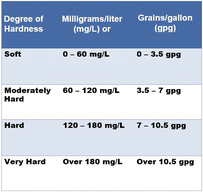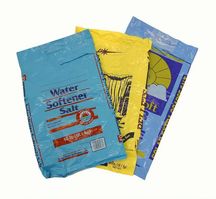
Do you live in a community
with hard water? Most Minnesotans do. A lot of us have experience with hard water’s unpleasant effects: dingy clothes, deposits on glassware and
cooking utensils, scale buildup in pipes and on fixtures, and more. It’s not surprising that water softeners are a popular household item.
Soft water has some notable benefits. Among others, it can extend the life and improve the efficiency of water heaters,
dishwashers, and other appliances, which potentially saves on water, energy, and detergent
use.
A major drawback of salt-based ion-exchange water softeners is the chloride they produce and discharge into septic or
sewage systems. Chloride from salt can seep into and pollute groundwater from on-site
septic systems. Chloride also enters the environment via wastewater treatment
facilities. Because facilities aren’t designed to remove it, chloride ends
up in rivers, lakes and streams. High levels of chloride in the environment are toxic to fish and aquatic creatures.
|
 If you own a water softener
or are thinking of getting one, read on for some strategies that can help
lessen their environmental impacts.
-
Determine if
you really need one. Hardness is determined
by the level of minerals, principally calcium and magnesium, contained in water
– the more minerals present, the harder the water. Groundwater is typically
harder than river or lake water. The table to the right provides a common classification
of water hardness.
Before buying a softener, have your water tested for hardness or ask your city for
information. Find out from your water utility if softening happens during the
drinking water treatment phase. Minneapolis, St. Paul, Bloomington, and several other Minnesota cities use
lime-softening or other upfront methods to soften their water, which eliminates or decreases the need for household treatment.
|

-
Reduce the
salt. Only soften the water that
needs it. Don’t soften water to outside spigots or to cold drinking
water taps. Only soften to the optimal hardness – over-softening wastes salt
and water and results in excess chloride. Check your unit's settings and adjust if they're too high – the equipment may have been preset at an unnecessarily high level at the factory.
Do things to reduce your overall water use. It will have environmental and economic benefits,
including less need for water softening. For ideas on how you can
conserve water in and around the home, see pca.state.mn.us/conserving-water.
-
Adjust the timer. If you’re using less water because of changes in household
size or because you’ve installed water-efficient appliances and fixtures—and
your water softener is on a timer—you may be able to extend the time between
regeneration cycles.
Less regeneration results in less chloride
in wastewater.
-
Upgrade to a high-efficiency water softener. If you're buying or upgrading to a new water
softener (a good idea if you own an older unit), look for one that is high salt-efficiency and demand-initiated. Though you may pay a little more upfront, you'll save on salt and generate less chloride.
-
Go with a
service. Another option is to
subscribe to an exchange service. The company delivers soft water exchange
tanks to the customer on a schedule determined by household size and water
hardness level. Removed tanks are regenerated at a special facility, taking the
handling of salt and solution discharge out of consumers’ hands.
Learn More
-
Chloride and
Water Quality, Minnesota Pollution Control Agency. In-depth information on chloride and water quality in Minnesota. Includes newly released policy proposal from the Chloride Working Group.
- Water Softener Facts, Region of Waterloo and City of Guelph. Canadian government website contains useful information on how water softeners work, what to look for when shopping for one, water softener alternatives, and more.
-
Water Hardness
Fact Sheet, Washington County Department of Public Health and Environment. Brief, informative overview of water hardness and water softeners.
|
Proposed legislation
threatens MPCA’s work
Several
of the large “Omnibus” bills under consideration in the Minnesota Legislature have
provisions that would change longstanding environmental protections in
Minnesota. MPCA leadership has testified against many of these provisions,
arguing they are attempts to fix so-called problems that do not actually exist.
In reality, they are an effort to hamstring our environmental work.
The
proposals:
• Reduce or eliminate
public input from some MPCA work
• Put
political considerations ahead of vetted science
• Introduce
uncertainty, red tape, and delay into required processes for Minnesota
businesses
The
policy changes would:
-
Restrict state water-protection tools
- Suspend all
water quality standards for two years. At least 90 cities and 40 large
processing/manufacturing businesses would be unable to get wastewater treatment facility permits
- Delay the
impaired waters list, creating an endless loop of bureaucracy.
Bog down rulemaking
-
Add new,
redundant, and unnecessary review provisions that would increase bureaucratic
processes and slow down our work.
-
Change
standards of proof, putting scientific decision-making in the hands of
administrative law judges instead of the MPCA’s engineers, soil scientists,
hydrologists, microbiologists, toxicologists, and other researchers with the
necessary expertise.
-
Delay
protection of wild rice by specifically
directing the agency to slow walk its wild rice rulemaking, currently in process.
Slow down permitting work
-
Ban a faster,
more flexible companion process to rulemaking in which the agency provides
guidance to regulated parties and avoids painstaking, formal rulemaking.
-
Add 15 days to
our permitting timeline, which conflicts with our 150-day goal.
- Set a hard and
fast deadline for permits that would hinder the proper handling of the most
complicated cases. 90% of all MPCA permits are now completed on or before the
150-day goal.
Funding issues
The
MPCA did not request increased funding from the Legislature in our FY 2018-2019
budget but instead proposed a flat budget. The legislative response so far has
been to make cuts. For example, language in the transportation and energy bills
puts at risk the $47 million due to Minnesota from Volkswagen as part of the
company’s settlement for cheating emissions testing on its vehicles.
As legislative
leaders work out compromises between House and Senate differences, agency
leaders are working hard to let legislators know what impact the proposals
would have on environmental protection in Minnesota.
 MN GreenCorps places AmeriCorps members with local
governments, non-profits, and educational institutions statewide to carry out
service projects on focused environmental topics. MN GreenCorps service is
full-time for approximately 11 months, beginning in September. For the
2017-2018 program year, members can serve in positions in the areas of:
- Air Quality (including Energy Conservation and Green Transportation)
- Waste Prevention and Recycling
- Green Infrastructure (including Local Foods, Stormwater
Management, and Urban Forestry)
- Living Green Outreach
MN GreenCorps members gain valuable skills and experience in
the environmental field while giving back to communities in Minnesota. Along
with a living allowance of $1,148 per month, members have the offer of health
insurance, loan forbearance, and upon completion, MN GreenCorps members receive
an education award of up to $5,815 that can be used for further education or to
pay off qualified student loans.
To receive a notification when the
application is open, please sign up here.
Member application materials and additional
information about the program will be available on the MN GreenCorps website. Please direct questions to mngreencorps.pca@state.mn.us.
|
|